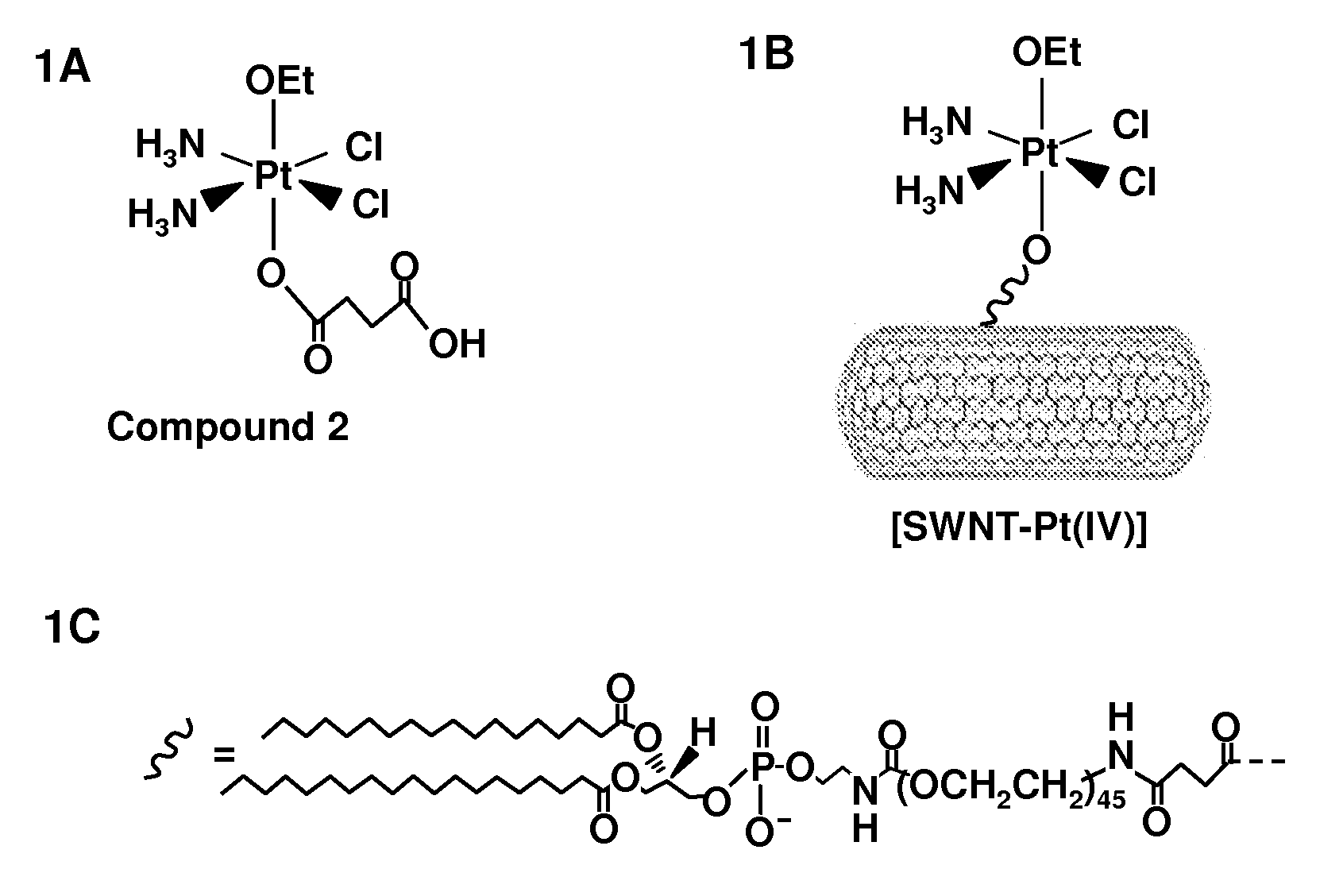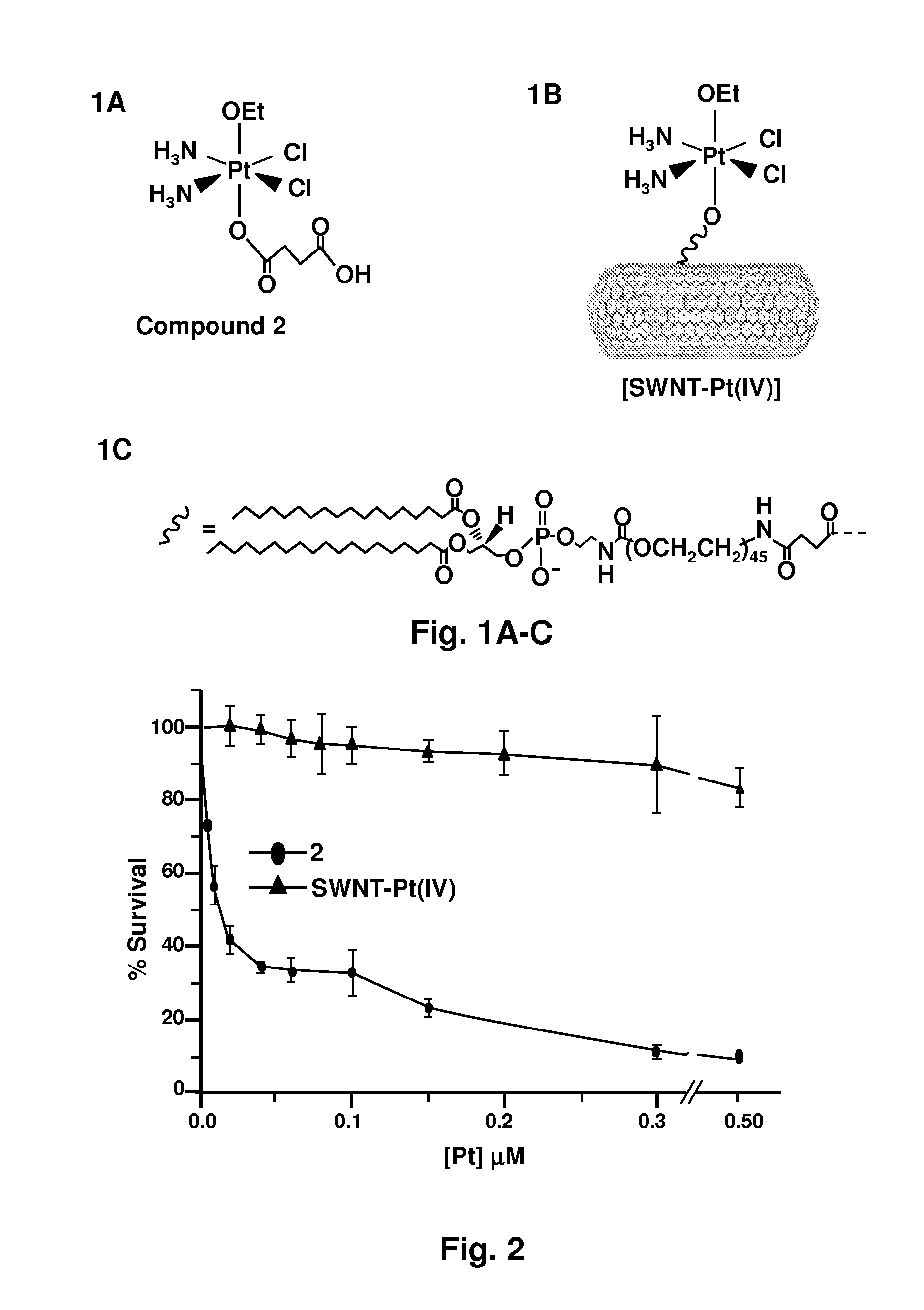Soluble Nanoparticles as Delivery Systems for Prodrugs
a technology of nanoparticles and prodrugs, applied in the field of nanoparticles, can solve problems such as activity in the body
- Summary
- Abstract
- Description
- Claims
- Application Information
AI Technical Summary
Benefits of technology
Problems solved by technology
Method used
Image
Examples
example 1
Preparation of Platinum (IV) Compounds, and Tethering to Amine-PEG-Phospholipid SWNT
[0078]Materials. cis-[Pt(NH3)2Cl2]1 and 6-carboxy-2′,7′-[dichlorofluorescein-3′,6′-[diacetate succinimidyl ester2 were synthesized as previously described. Distilled water was purified by passage though a Millipore Milli-Q Biocel water purification system (18.2 MΩ) with a 0.22 μm filter. NHS, EDC, paraformaldehyde, and succinic anhydride were purchased from Aldrich. All other solvents and reagents were obtained from VWR International and used as received. 1H NMR (Nuclear Magnetic Resonance) spectra were recorded on a Varian Mercury Inova-500 spectrometer and 195Pt NMR spectra were recorded on a Varian Inova-500 spectrometer in the Massachusetts Institute of Technology Department of Chemistry Instrumentation Facility (MIT DCIF). Atomic absorption spectroscopic measurements were taken on a Perkin Elmer AAnalyst300 spectrometer.
[0079]Synthesis of SWNT-PL-PEG-NH2. SWNTs made by a high pressure CO (Hipco...
example 2
Electrochemical Studies of Compounds 1 and 2
[0084]Each platinum complex was dissolved to a final concentration of 2.0 mM in 0.1 M aqueous KCl buffered with phosphate to either pH 6.0 or 7.4. Cyclic voltammetric (CV) measurements were performed with a model 263 EG&G Princeton Applied Research electrochemical analyzer at varying scan rates of 20-100 mV s−1. The solvent was degassed by several freeze-pump-thaw cycles and measurements were taken under an atmosphere of argon. The working electrode was made of glassy carbon, the reference electrode was Ag / AgCl, and the counter electrode was a platinum wire. Reported potentials are extrapolated to 0.0 mV s−1 scan rates to account for the irreversible behavior of the reduction processes.7
[0085]Electrochemical studies of compounds 1 and 2 showed the expected irreversible reduction maxima in their cyclic voltammograms corresponding to loss of the axial ligands. At pH 7.4 the reduction potentials extrapolated to 0.0 mV s−1 scan rate for 1 and...
example 3
Cell Cultures Showing Cytotoxicity of Compounds as Taken up by Cells
[0086]Cell Culture. Cells from the human testicular cancer line NTera-2 were incubated at 37° C. in 5% CO2 and grown in DMEM (Dulbecco's Modified Eagle's Medium) medium supplemented with 10% fetal bovine serum and 1% penicillin / streptomycin. Cells were passaged every 3 to 4 days and reseeded from frozen stocks after reaching passage number 20.
[0087]Cell Fixing Solution. Paraformaldehyde (4.0 g) and NaOH (0.4 g) were dissolved in 100 mL of distilled water. A 1.68 g portion of NaH2PO4 was added and the pH was adjusted with NaOH and HPO4 to be between 7.5 and 8.0. Sucrose (4.0 g) was added and the resulting solution was stored at 4° C. until use.
[0088]Cell Extract Preparation and Analysis. NTera-2 cells were grown to >90% confluence in 175 cm2 flasks. These cells were treated separately with 1 μM concentrations of cisplatin, c,c,t-[Pt(NH3)2Cl2(OEt)(O2CCH2CH2CO2H)], and SWNT-Pt(IV) and subsequently incubated for thre...
PUM
| Property | Measurement | Unit |
|---|---|---|
| Length | aaaaa | aaaaa |
| Polarity | aaaaa | aaaaa |
| Solubility (mass) | aaaaa | aaaaa |
Abstract
Description
Claims
Application Information
 Login to View More
Login to View More - R&D
- Intellectual Property
- Life Sciences
- Materials
- Tech Scout
- Unparalleled Data Quality
- Higher Quality Content
- 60% Fewer Hallucinations
Browse by: Latest US Patents, China's latest patents, Technical Efficacy Thesaurus, Application Domain, Technology Topic, Popular Technical Reports.
© 2025 PatSnap. All rights reserved.Legal|Privacy policy|Modern Slavery Act Transparency Statement|Sitemap|About US| Contact US: help@patsnap.com



